Have you ever considered pursuing sponsorship as a type of support for your art business? Sponsorship is a form of advertising in which a company chooses deliberately to associate with a particular individual who already has an audience. You’re familiar with one of the most well-known forms of sponsorship, though it may be so ubiquitous that you barely notice it: product placement.
But product placement is not the only kind of sponsorship available, and in fact there may be much better options available for business-savvy artists with an active audience. You’re probably not going to cover your smock with business logos a la NASCAR, but you may find that municipal or artist coalition sponsorships are a great match for the kind of work you create.
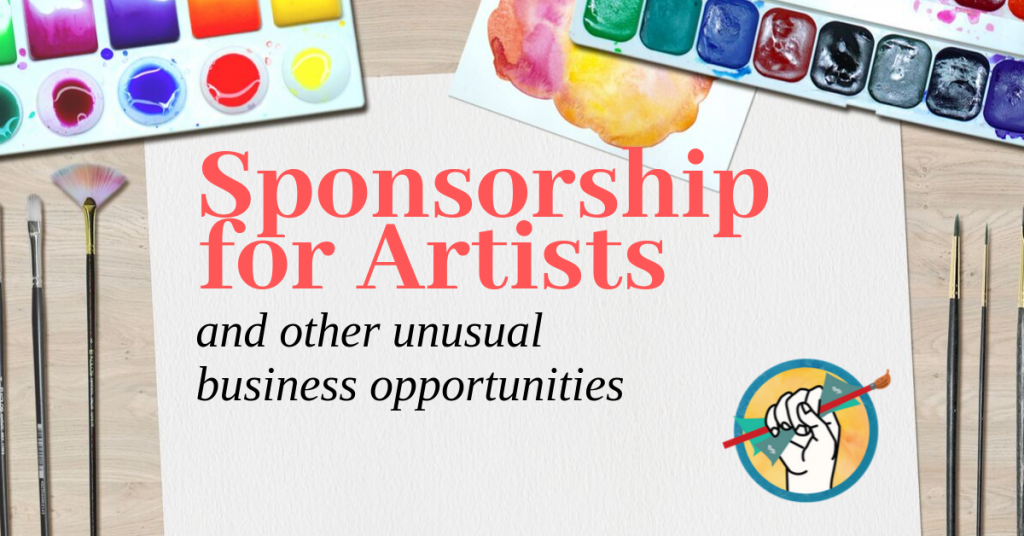
Why should artists bother with sponsorship? Sponsorship may be the best option for artists who work on large or complicated installations or are working in unusual or experimental media. Artists who are working in multiple mediums or creating pieces that cannot be easily sold as originals or prints (think multimedia installations) may also benefit from sponsorship. Isaac Julien’s “moving image” film installation is a good example of work that benefited greatly from corporate sponsorship: https://www.artsy.net/article/artsy-editorial-new-era-of-corporate-art-sponsorship
But what if you’re not creating large multimedia installations intended for museums? Is sponsorship an avenue worth exploring for the average artist just trying to make a decent living? We think the answer is yes. We’ve put together a list of some of the most common types of sponsorship- you may be surprised at the possibilities.
Product placement
“Product placement” might make you think of this or that large cola brand, or it may bring to mind a certain chocolate and peanut butter candy that made a bold choice to be featured in a 1982 science-fiction film featuring a certain lovable extra-terrestrial.
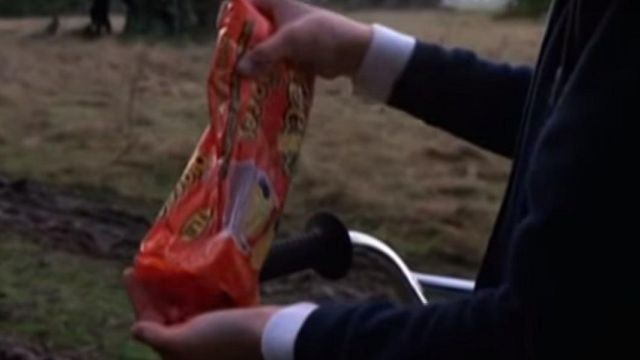
But product placement isn’t just for film. Between YouTube, IGTV, and the rising popularity of live streaming art on platforms like Periscope and Twitch, artists have an opportunity to leverage their popularity before art supply brands to get themselves free products and monetary sponsorship. (See our guide to live streaming.)
The first thing to understand is that corporate sponsorships like product placement are not for newbies. Unless you have already built a business and cultivated an audience and are now ready to branch out into streaming or other video content, you’ll need to spend the time and put in the hours to build your brand before you can approach potential sponsors. Consider the sponsor’s perspective. This aspect of research is not too different from researching influential Instagram partners (see our conversation with Anita Nowinska for more on leveraging influencers)- consider what you have to offer, not just what you can get out of the deal. Who is your audience? What do they like? What products are they likely to want to purchase? If you produce live art streams or tutorial videos aimed at other artists who want to learn from you, then you may be a good candidate for sponsorship from art supply companies.
How do I get a product placement sponsorship?
Before you begin reaching out to potential sponsors, you will want to take a good look at the current state of your business. Visit your website and social profiles as if you were a potential sponsor. Would you like what you see? Here are a few good practices to begin before you ever send an introductory email to a potential sponsor:
Start name dropping
It will be jarring for your audience if you never once mention a brand or company and then one day are suddenly sponsored by one and you mention them in every other post. One way to dip your toes into the world of product sponsorship is by including product reviews or shout outs in your content. Many artists post images of their work along with a caption detailing the brands of all the supplies they use- many fans ask for this information anyway. It’s very easy to produce a slick-looking flatlay image for Instagram with tags for each material pictured. (For more on how to photograph a flatlay, check out our interview with Maggi Mcdonald.) Tagging is also a quick way to get a company’s attention, if they’re on Instagram as well. Honestly and authentically sharing products that you love will let companies know that you can be trusted to talk about their products.
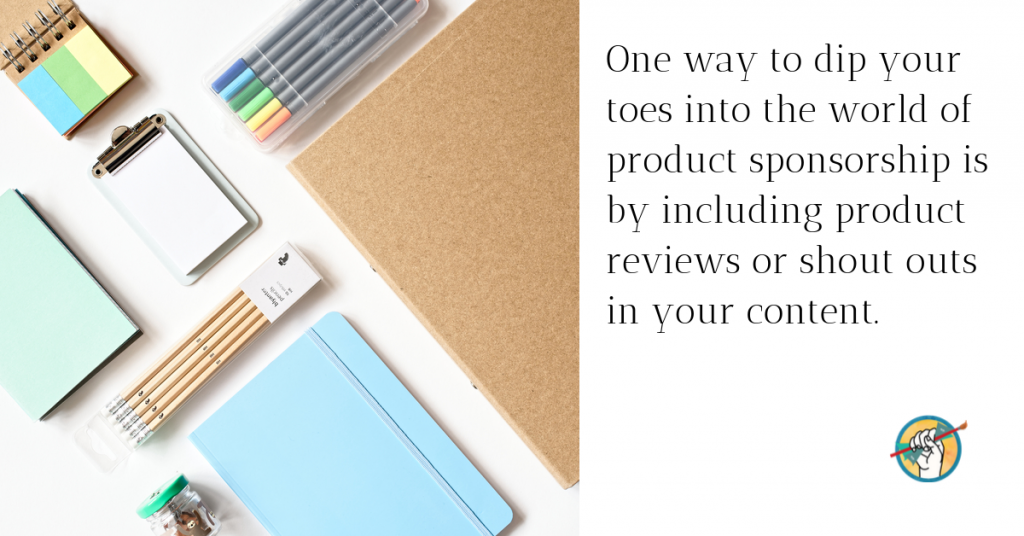
Be professional
A sponsoring company will want to know that the brand they are associating with is consistent and professional. Many larger companies actually use marketing agencies to vet potential artists (of all kinds). Those professional vetters will be looking for telltale signs that you may not be a good fit for certain brands: profanity, racist/sexist jokes, NSFW content (this likely wouldn’t include figure drawing), unprofessional interactions with fans, or inconsistency in schedule or content will all be likely to exclude you from a lot of potential sponsors. Before you begin your search for sponsorship in earnest, clean up your feeds.
Pay attention to your branding
Your brand may just be yourself, and that’s fine, especially for artists. The key is to be deliberate and consistent about your branding. Take a look at your social profiles, video channels and streams, and especially your website to make sure that your branding is consistent across all platforms. What’s your messaging? How to Sell Your Art Online 101 will be a really helpful refresher for identifying your audience (which should overlap significantly with your potential sponsor’s audience) as well as your own story and the voice in which you tell it.
How do I find companies to sponsor me?
There are a few websites out there that purport to connect artists with potential sponsors. You may want to check out Indiesponsor, which for $9 a month will provide you with a profile page and access to a list of sponsor opportunities.
You may want to start simply by making a list of the products you wouldn’t mind shilling for. Are you a major Wacom fan, or do you live and breathe Adobe? Do you casually evangelize for Prismacolor or Dr. Ph. Martin? Make a list of the brands you use and love. From there, do some searching for similar brands, because it’s not terribly likely to strike gold with the first big company you think of. But smaller companies who don’t have the budget for big timers may be much more willing to partner with you.
Try researching products that would be a good fit for your brand with ProductHunt, a website that lists the latest newly launched products across the internet. Companies launching new products will be especially interested in building momentum and garnering interest through strategic product placement sponsorships.
Making the Ask
Once you’ve done the research and prepared your business, how do you convince companies to sponsor you? Most importantly, you need a clear understanding of how the potential sponsor will be benefiting from the partnership. Will your work bring new attention or new business to the company? Is your art associated with a charitable cause that will make the company look really good for sponsoring you? Write down clearly how the sponsor will benefit from association with you and your work.
What does making the ask look like? Picture a business on a busy street. The business has a blank wall that faces traffic. An artist writes a proposal that lays out clearly for the company how a bright and eye-catching mural will attract attention to their business. It includes a clear budget, and asks the company to sponsor the mural. The company gets attention, the artist gets work… everybody’s happy!
What if you’re not a muralist? The basic method is still the same: present to the company a proposal that includes your vision for the finished piece, and lays out clearly how the sponsoring company will benefit. Will you hold an event when the piece or installation is finished? How many people will show up? How many people do you expect to see the piece (and to see the sponsoring company’s involvement?) These details will assist the company in deciding whether the project is worth paying for. The more enticing you can make your project look for the sponsoring company, the better your chances of success.
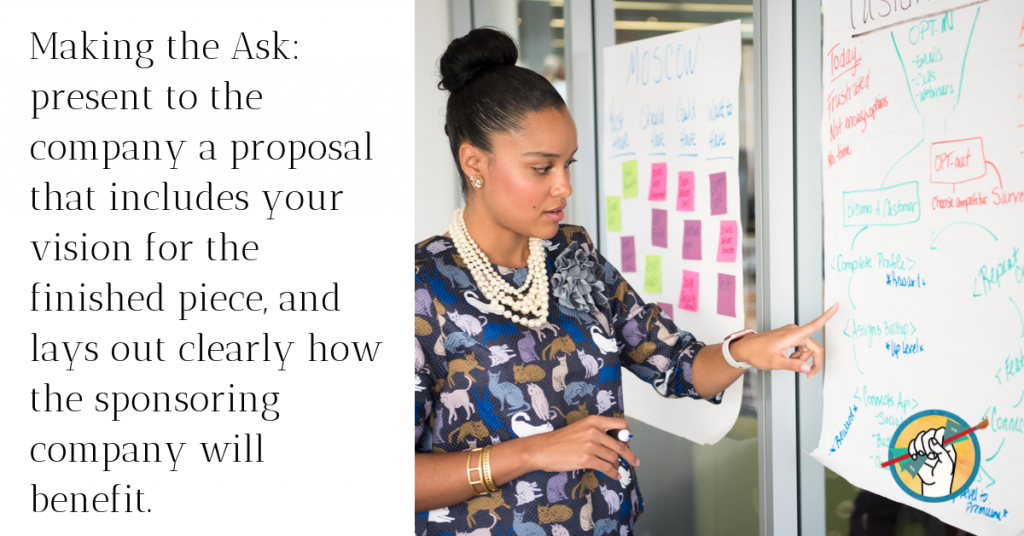
Meet David Choe
We used a mural as an example of a sponsorship partnership between an artist and a company. A case from Silicon Valley, the hotbed of creativity and out-of-the-box thinking itself, has proven that a little creative thinking can produce endless possibilities for alternative ways for artists to collaborate with businesses and organizations.
Perhaps you’ve heard of David Choe- the graffiti artist who agreed to be paid in stock by a small Silicon Valley startup back in 2005, in exchange for painting the entire building. He had initially asked for $60,000 for the project, but after seeing PayPal cofounder Peter Thiel invest in the company, and with a bit of a taste for risk-taking, he agreed to the unorthodox payment method. The company was Facebook, and Choe is now worth $200 million.
Naturally, this is not going to be the fairy tale ending for every artist who enters into an unusual sponsorship agreement, but it’s proof that artists who aren’t afraid to take risks and think outside the box may be rewarded for their optimism.
Municipal sponsorship
Municipal sponsorship will vary from city to city depending on your town’s individual art programs and budgetary priorities. Municipal sponsorship can take a variety of forms, from monetary contribution to arts festivals to hiring artists to create murals and sculptures. There is publicly funded sponsorship out there for artists- it may just be a matter of finding it. “According to Americans for the Arts, in 2015, 35% of local arts agencies (LAAs) provided financial support to individual artists, and 30% supported both arts organizations and artists.” (Grantspace)
How do I Get Municipal Sponsorship?
Get plugged in
The best way to find these kinds of sponsorships is to get familiar with your local government. Make friends with individuals inside city hall, scour the city government website, and join your local artist’s guild to connect with other local artists, some of whom are likely to know their way around your local municipal sponsorship structure.
Explore what’s available
One simple example of a municipal sponsorship is a mural grant, which is a relatively ubiquitous form of public arts sponsorship which allows a single artist, artists group, business, or nonprofit to put together a public mural along established guidelines, often with monetary assistance attached. Try Googling “Your city + mural + application” to get an idea of what may be available in your city. Here’s an example from the city of Milwaukie near Portland, Oregon: https://www.milwaukieoregon.gov/arts-committee/public-art-mural-guidelines-mural-application
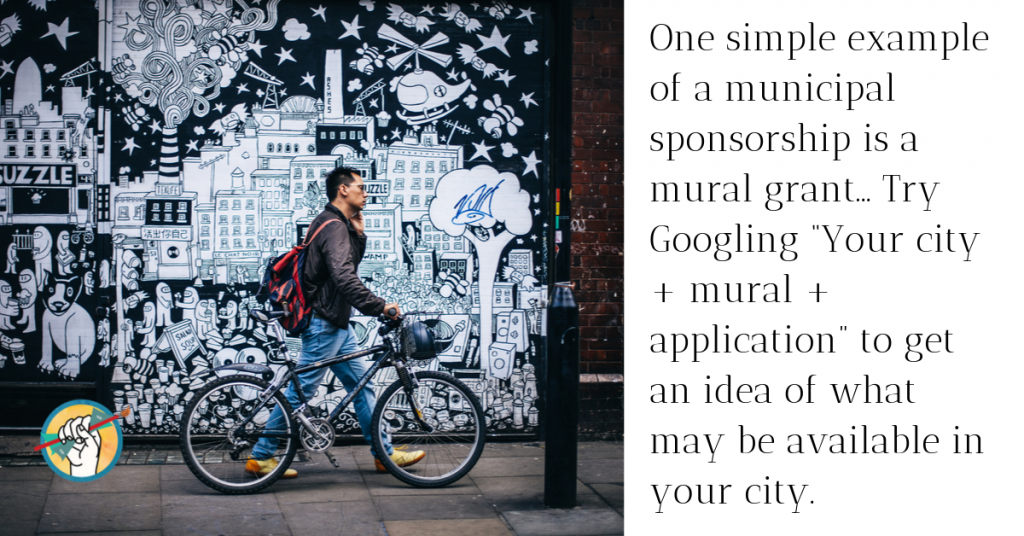
Evaluate your work
If you’re interested in pursuing municipal sponsorship, your first step should be evaluating your artwork and your messaging. How can you provide value to your town with your art? It may not be a mural or any kind of art in a public space- it may be a series on local landmarks, town founders, or a relevant political issue that impacts your city. Getting involved with your town’s local arts organizations, planning committees, etcetera is one of the best ways to get your finger on your town’s pulse and determine how you can best partner with it to produce art that your local municipality would be excited to sponsor.
Artist coalitions and nonprofits
Artist coalitions and charities are organizations that exist to support and fund artists. These may be less restrictive in what they allow than municipal bodies. On the other hand, they may be extraordinarily specific in the kind of art they support, which can be an advantage depending on the kind of art you create.
Determining which arts-focused nonprofits are a good fit for your work is going to require research. Try greatnonprofits.org, which currently provides a 50-page list of arts and culture nonprofits complete with extensive reviews and contact information. (Be aware that not all of the nonprofits listed there provide money to artists- some solicit free art from artists for placement in locations like hospitals.)
Artist coalitions most often support public cultural projects and events, and often require artists to submit an official grant proposal. Try searching for “Your city + artist coalition” to see what’s available. For some really helpful information on how to write grant proposals, check out our post How to Write Grants for Your Art Project.
Patronage
Patronage most often brings to mind wealthy benefactors commissioning gilded-frame oil portraits in centuries long since passed, but patronage as a model is alive and well today, although it’s shifted somewhat and taken on new life on the internet. Patreon is one such example, a blend of crowdfunding and traditional patronage that allows fans to support an artist’s work on a monthly basis in exchange for closer access to the artist, sneak peeks behind the scenes, and first/exclusive access to commissions and extra artwork.
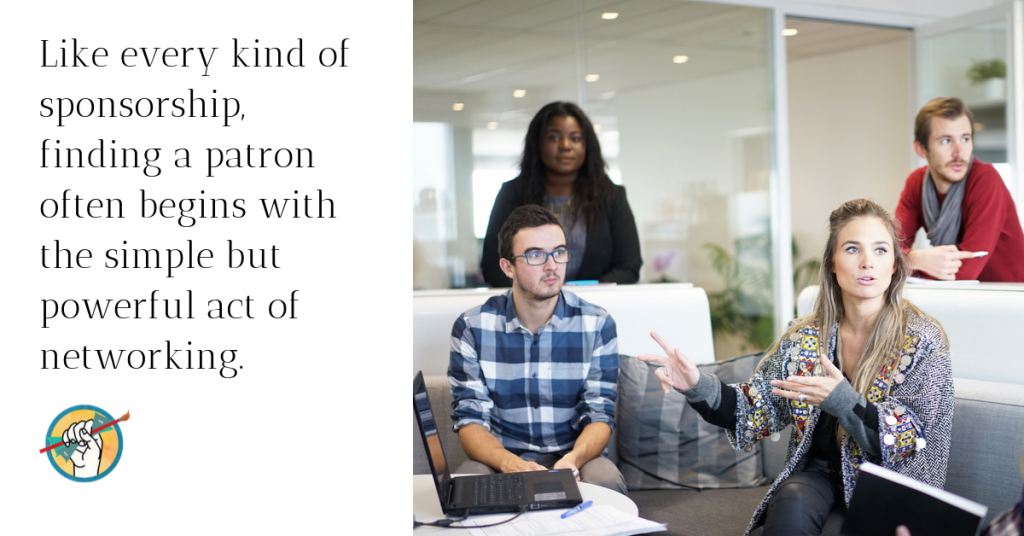
A brief history of artist patronage
Art patronage is as old as the imperialist and feudalist societies in which it has most often been found throughout history. The distinct origins of the patronage model are unknown, although it most often was heavily tangled in politics. In fact, in many societies patronage was the key to social mobility and status. Michelangelo’s most famous patron was Pope Julius II, which had just as much to do with the famed artist’s rise to prominence as did his remarkable talent.
Modern artist patronage seemed to have disappeared for a time, receding to a type of organizational support such as underwriting a ballet or a museum exhibit, but according to a NYT article on patronage: “Funding based on a collection model is backward,” said RoseLee Goldberg, an art historian at New York University and the founder of the performance art nonprofit Performa. “There isn’t this support for an artist if they don’t have big object to sell.” Ms. Goldberg believes today’s patrons are similar to the “angel investors” of tech. “You see that something has potential to grow and you want to support that incubation period,” she said.”
Where to find contemporary arts patronage
Contemporary artists may continue to see an uptick in more traditional patronage through incubator programs like In4Art, which matches patrons with artists and underwrites materials and “creative development”, that aforementioned incubation period.
Patreon, as mentioned before, is also a valid model of patronage, with a modern twist. Financial Times describes it this way in an article on modern patronage: “The model is less like the Victorian system of arts patronage, in which benefactors subscribed to put up a statue, and more like the aristocrats who clubbed together to give Beethoven a life-long stipend “to make my life trouble-free”, as the composer wrote.”
Like every kind of sponsorship, finding a patron often begins with the simple but powerful act of networking. Try volunteering for museums and other arts organizations that connect regularly with arts patrons.
Regardless of the sponsorship method, the artist that is going to find the most success at securing sponsorship will be the one who has paid close attention to how they represent their brand, tell their story, and stand out in the market. If you need some help solidifying what your art’s message is and how to share it with interested potential sponsors, check out How to Sell Your Art Online 101: The Story of Your Art
peace greetings,
what if a poor artist, with great talent but can’t buy even the materials for painting art ?
can this kind of artist get a sponsorship ?
i found a very needy but very talented painting artist with one wife and tree daughters in Indonesia.
please respond,
thank you and God bless this kind of sponsorship ministry, Amen.
How can artist who can’t afford art metarial be sponsored but having a good talent and good skills?
Is the any luck for those artists?
I would be glad to know how can they be supported.
I create a comic series for a magazine, and blog, and use the character in various content, campaign ad, and marketing that my sponsors would like to use, I incorporate the products and brand into my blog and twice a month comic series. They pay me monthly to do so. It’s all about have a strong idea of what you are doing and who you are doing for, and the sponsor, just has to see where this can go, how it can move forward and benefit them.
I would like to sell my art and get a sponsorship for my art